Updated March 21, 2025 Authored by Chris Cloney and Jon Barrett
Protect your workplace from combustible dust hazards. Learn about global combustible dust standards, compliance strategies, and industry best practices.

Combustible dust may seem harmless, but in industrial settings, it can cause deadly explosions. Many businesses don’t fully understand the safety regulations designed to prevent disasters.
However, different regions have different rules—OSHA in the U.S., ATEX in Europe, NFPA guidelines, and more. Keeping up with these evolving standards can be confusing, and non-compliance can lead to fines and serious safety risks.
This comprehensive guide explains how to navigate safety rules, avoid legal trouble, and protect workers. Stay informed, stay compliant, and keep your workplace safe.
Key Takeaways:
-
- Awareness is Key: Recognize the hidden danger of combustible dust in various industries and understand that raising awareness among your team is the first step in preventing potentially devastating combustible explosions.
- Proactive Risk Assessment: Conduct thorough risk assessments to identify areas with combustible dust hazards. This proactive approach helps you pinpoint vulnerabilities and implement targeted prevention measures.
- Compliance is Non-Negotiable: Stay up to date with industry regulations and standards. Compliance not only ensures safety but also safeguards your organization from legal consequences and fines.
- Prevention over Reaction: Prioritize prevention over reaction by investing in proper housekeeping practices, dust collection systems, and combustible dust explosion protection measures. Prevention significantly reduces the likelihood of a combustible dust explosion.
- Continuous Learning and Improvement: Embrace a culture of continuous improvement in combustible dust safety. Regular training, education, and ongoing review of safety practices are essential to stay ahead of evolving risks and protect your workforce effectively.
Stay ahead of regulations and reduce risk—join our comprehensive training and ensure a safer work environment today!
Table of Contents:
-
- How Combustible Dust Explosions Occur
- Why are Combustible Dust Standards and Regulations Important?
- National Fire Protection Association, (NFPA), Standards for Combustible Dust
- Occupational Safety and Health Administration, (OSHA), Regulations for Combustible Dust
- The Revised Combustible Dust National Emphasis Program, From OSHA
- Combustible Dust and OSHA Regulations
- American Society for Testing and Materials International, ASTM, Standards for Combustible Dust
- IEC Standards for Combustible Dust Safety
- International Organization for Standardization, ISO regarding Combustible Dust
- ATEX, “Atmosphere Explosibles,” and Regulations for Combustible Dust
- CEN, European Committee for Standardization, Regarding Combustible Dust
- Underwriters Laboratory Combustible Dust Certification
- VDI, Verein Deutscher Ingenieure, Safety Standard Regarding Combustible Dust
- The International Fire Code (IFC) Chapter 22, Regarding Combustible Dust
- Key Prevention Measures for Combustible Dust Explosions
- Conclusion
How Combustible Dust Explosions Occur
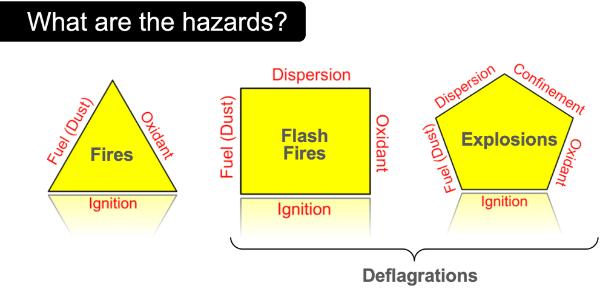
The scientific principles underlying combustible dust explosions include the detailed breakdown of the combustion process, the factors that influence dust explosions, and key concepts such as Minimum Ignition Energy (MIE), Minimum Explosible Concentration (MEC), and others.
Detailed Breakdown of the Combustion Process:
Combustible dust explosions follow a sequence of events that can be understood as a complex chemical reaction:
-
- Fuel: Fine particulate matter, such as dust or powdered materials, serves as the fuel. It can originate from various sources, including wood, metals, plastics, chemicals, and organic materials.
- Oxygen: The oxygen in the air acts as an oxidizer, required for combustion to occur.
- Ignition Source: An ignition source, which can be a spark, open flame, hot surface, friction, or electrical discharge, initiates the combustion process.
- Dust Suspension: Dust particles become suspended in the air, forming a dust cloud. The concentration of dust in the cloud must be within a specific range to support an explosion.
- Ignition: The dust cloud encounters an ignition source, causing the combustion of the suspended dust particles.
- Rapid Combustion: The combustion propagates throughout the dust cloud at an astonishingly high rate, generating pressure waves and fireballs, leading to an explosive release of energy.
Factors Influencing a Combustible Dust Explosion (Fire Triangle for Dust):
The factors that influence combustible dust explosions can be conceptualized using a “Fire Triangle” analogy, which includes three key elements
-
- Fuel (Combustible Dusts): The type and properties of the combustible dusts play a significant role in the likelihood of an explosion. Factors such as particle size, shape, chemical composition, and moisture content affect the explosiveness of the dust.
- Oxygen (Air): The availability of oxygen in the air, often expressed as oxygen concentration, must be within a specific range to support combustion. Insufficient or excess oxygen can inhibit explosion propagation.
- Ignition Source: The presence of an ignition source is critical. Common sources include electrical equipment, welding operations, friction from moving machinery, and hot surfaces. Preventing or mitigating potential ignition sources is a key safety measure.
Key Terms and Concepts:
-
- Minimum Ignition Energy (MIE): MIE is the minimum amount of energy required to ignite a dust cloud when the air-fuel mixture is within its explosible range. It is typically measured in millijoules (mJ).
- Minimum Explosible Concentration (MEC): MEC is the lowest concentration of combustible dust in the air, which can support a dust explosion when an ignition source is present. Below this concentration, the mixture is too lean to explode; above it, the mixture is too rich.
- Dust Cloud Flammability Limits: These limits define the range of dust concentrations in which an explosion can occur. The lower explosive limit (LEL) and upper explosive limit (UEL) are specific concentrations below and above which explosions cannot occur.
- Dust Deflagration: A dust deflagration is a rapid combustion of dust that propagates at subsonic speed, generating pressure and fire but not a shockwave.
- Dust Detonation: A dust detonation is a supersonic combustion that produces shockwaves, leading to more destructive explosions. These are uncommon in most industrial processes but may be possible in coal mining applications.
Understanding the science behind combustible dust explosions, along with these key terms and concepts, is crucial for industries that handle combustible materials. It enables them to assess and mitigate the risks associated with dust, ensuring the safety of workers and preventing catastrophic incidents.
Why are Combustible Dusts Standards and Regulations Important?
Combustible dusts are a serious workplace hazard that can lead to catastrophic incidents if not properly managed. To mitigate the risks associated with combustible dusts, various standards and regulations have been put in place. Listed are the importance of combustible dust standards and regulations and why they are crucial for the safety of workers and the prevention of industrial disasters.
Protecting Worker Safety
One of the primary reasons for the existence of combustible dust standards and regulations is to ensure the safety of workers. Combustible dusts can be found in various industries, including manufacturing, agriculture, and food processing. When not managed correctly, it poses a severe threat to employees’ health and well-being. These regulations set guidelines for the identification, control, and prevention of combustible dust hazards in the workplace, ultimately reducing the risk of accidents, injuries, and fatalities.
Preventing Catastrophic Incidents
The devastating consequences of combustible dust explosions are well-documented. These incidents can lead to loss of life, extensive property damage, and severe environmental impacts. By adhering to established standards and regulations, industries can significantly reduce the likelihood of such catastrophic events. Proper dust management, including adequate ventilation, dust collection systems, and regular maintenance, is essential to prevent explosions.
Legal and Financial Liability
Non-compliance with combustible dust standards and regulations can result in legal and financial repercussions for businesses. In the event of an incident, companies that fail to meet safety standards may face lawsuits, fines, and even criminal charges. Adhering to regulations not only helps protect workers but also safeguards a company’s reputation and bottom line.
Industry-Specific Guidelines
Different industries have unique characteristics and requirements when it comes to managing combustible dusts. Combustible dust standards and regulations are often tailored to specific sectors, taking into account the types of dust generated, processes involved, and potential hazards. These industry-specific guidelines ensure that businesses can effectively address the unique challenges they face.
Knowledge and Best Practices
Combustible dust standards and regulations are not static; they evolve over time based on research, experience, and technological advancements. They incorporate the latest knowledge and best practices in dust control and safety measures. Staying up-to-date with these regulations helps industries adapt to new insights and tools for improved safety. Continuing education is a best practice approach and is presented with Scientific Methods.
International Harmonization
In a globalized world, businesses often operate across borders. International harmonization of combustible dust standards and regulations ensures a consistent approach to safety, regardless of where a facility is located. This not only simplifies compliance but also contributes to a safer working environment on a global scale.
Combustible dust standards and regulations play a critical role in protecting worker safety, preventing catastrophic incidents, and avoiding legal and financial liabilities. They provide guidelines for the safe management of combustible dusts in various industries and serve as a foundation for knowledge and best practices. Compliance with these regulations is not just a legal requirement but a moral obligation to ensure the well-being of employees and the sustainability of businesses.
Don’t wait for a disaster to strike—sign up now to master essential safety protocols for combustible dust hazards!
National Fire Protection Association (NFPA) Standards for Combustible Dust
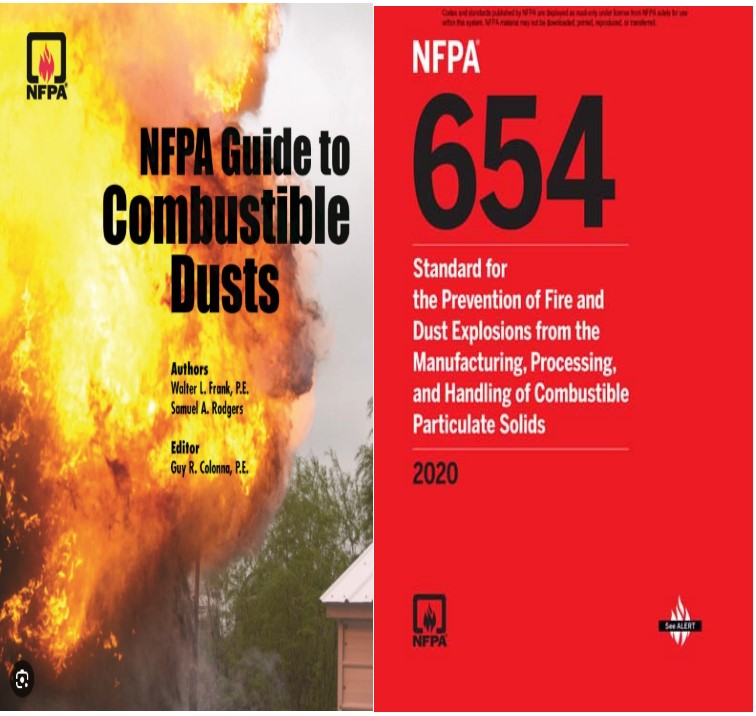
Combustible dust explosions pose a significant risk in various industrial settings, from manufacturing plants to grain elevators. These explosions can result in devastating consequences, including loss of life, property damage, and environmental harm. To mitigate these risks and promote safety, the National Fire Protection Association (NFPA) has established a comprehensive set of guidelines and standards concerning combustible dust hazards, including a dust hazard analysis.
Understanding Compliance and Its Importance:
Compliance with NFPA standards and regulations related to combustible dusts are important for multiple reasons. These guidelines have been developed through extensive research, data analysis, and input from industry experts. They provide a roadmap for organizations to identify, assess, and mitigate combustible dust hazards in their operations.
Safety and Risk Mitigation: Compliance with NFPA standards ensures that organizations take proactive measures to reduce the risk of combustible dust explosions, including a dust hazard analysis. This, in turn, protects the safety of workers and the general public, minimizing the potential for injury, fatalities, and property damage.
Legal Obligations: In many jurisdictions, compliance with NFPA standards is a legal requirement. Failing to adhere to these regulations can result in penalties, fines, and legal liabilities. It’s imperative for organizations to meet these obligations to avoid legal consequences.
Industry Best Practices: NFPA standards are considered industry best practices. Following these guidelines not only enhances safety but also reflects positively on the reputation of an organization. It demonstrates a commitment to safety and professionalism, which can attract customers and business partners.
Insurance Considerations: Many insurance providers consider NFPA compliance as a factor when determining premiums and coverage. Non-compliance can result in increased insurance costs and reduced coverage options. Maintaining compliance with NFPA standards can, therefore, have a direct impact on an organization’s bottom line.
Emergency Preparedness: NFPA guidelines not only focus on preventing combustible dust explosions but also on emergency preparedness in case of an incident. Compliance ensures that organizations have protocols and systems in place to respond effectively and minimize the impact of any explosion.
Continuous Improvement: NFPA standards are continuously updated and improved based on new research and lessons learned from incidents. Staying compliant necessitates ongoing assessment and adaptation of safety measures, promoting a culture of continuous improvement within organizations.
NFPA Combustible Dust Standards
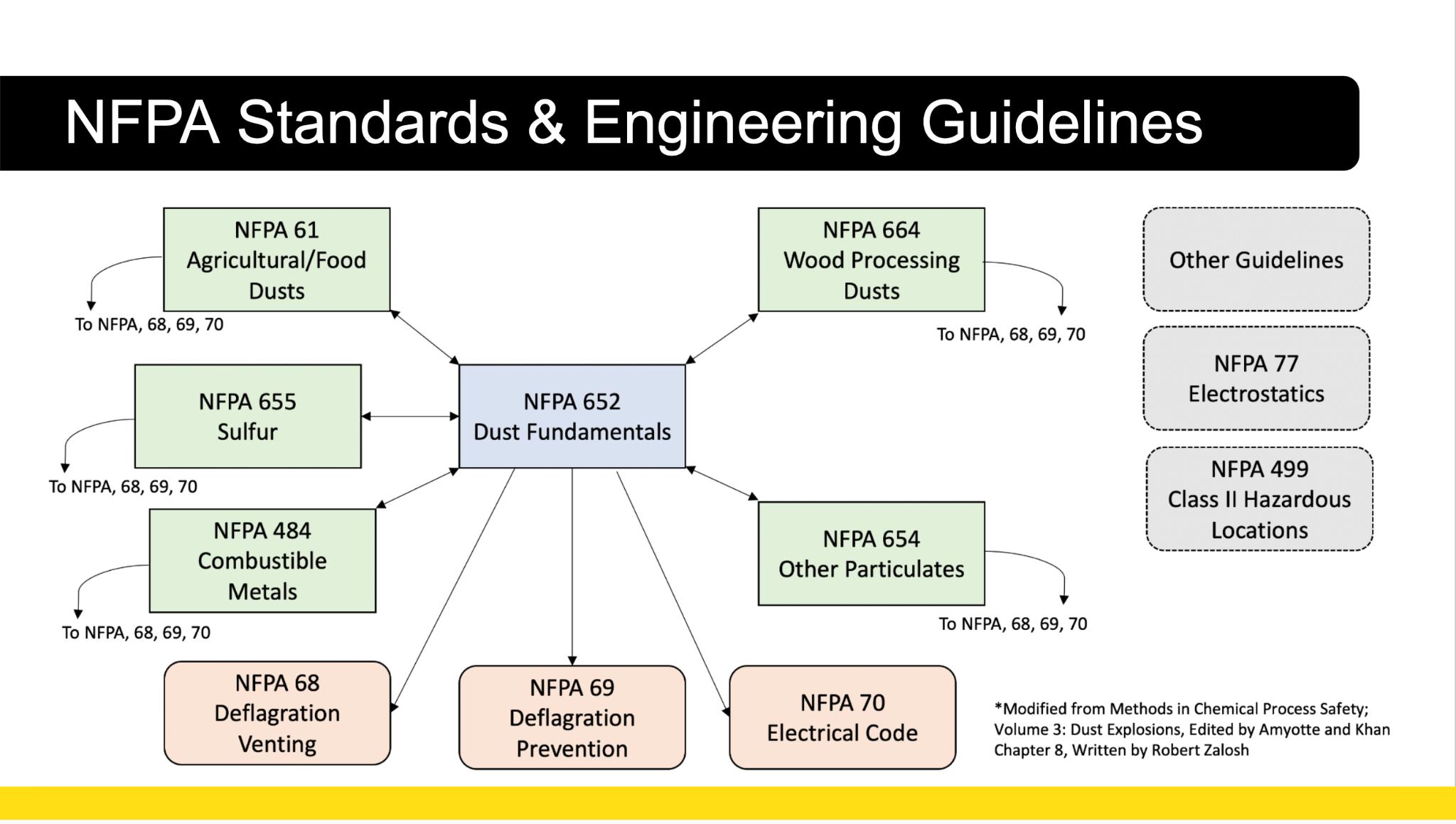
The NFPA has developed several standards and regulations pertaining to the control and mitigation of combustible dust hazards, including a dust hazard analysis. Some of the most relevant ones include:
NFPA 652: Standard on the Fundamentals of Combustible Dust: NFPA 652 sets the groundwork for managing combustible dust hazards by defining terminology, outlining requirements for conducting hazard assessments, and establishing principles for dust collection system design.
NFPA 654: Standard for the Prevention of Fire and Dust Explosions from the Manufacturing, Processing, and Handling of Combustible Particulate Solids: This standard delves into the specifics of preventing fires and dust explosions in facilities that handle combustible dust. It provides guidelines on dust collection systems, including design, maintenance, and inspection, system design, ignition source control, and dust control measures.
NFPA 68: Standard on Explosion Protection by Deflagration Venting: NFPA 68 outlines the principles for safely venting the pressure generated during a dust deflagration (an explosion that propagates at subsonic speeds). This standard helps in designing dust collection systems with appropriate venting mechanisms to protect workers and facilities.
NFPA 61: Standard for the Prevention of Fires and Dust Explosions in Agricultural and Food Processing Facilities, is a vital document established by the National Fire Protection Association (NFPA) in the United States. This standard offers comprehensive guidelines and requirements to mitigate the risk of fires and explosions in facilities involved in agricultural and food processing activities. NFPA 61 covers various aspects, including the handling, processing, conveying, and storage of agricultural and food materials that could generate combustible dust.
The standard outlines specific measures for preventing and controlling dust accumulation, designing equipment and systems to minimize ignition sources, implementing proper ventilation and dust control systems, conducting regular inspections, and training employees on safety protocols. NFPA 61 emphasizes the importance of maintaining a safe environment by adhering to stringent practices, thereby reducing the potential for dust-related incidents that could lead to severe consequences such as injuries, fatalities, and facility damage.
NFPA 655: Standard for the Prevention of Sulfur Fires and Explosions, specifically focuses on sulfur-related industries, covering aspects such as sulfur production, transportation, storage, handling, and processing. It details essential safety measures to control sulfur dust, minimize ignition sources, and prevent the accumulation of combustible materials that could lead to fires or explosions.
Key elements of NFPA 655 include recommendations for controlling sulfur dust emissions, designing and maintaining equipment to mitigate fire and explosion risks, implementing proper ventilation and dust control systems, conducting regular inspections, and providing training to personnel on safety protocols.
NFPA 68: Standard on Explosion Protection by Deflagration Venting, is a crucial document established by the National Fire Protection Association (NFPA) in the United States. This standard provides comprehensive guidelines and requirements for the design, installation, operation, and maintenance of deflagration venting systems used to mitigate the hazards of combustible dust or vapor explosions.
NFPA 68 focuses on strategies to minimize damage caused by explosions in various industries where combustible materials are present, such as manufacturing, processing, and storage facilities. The standard outlines principles and practices for designing and installing venting systems that safely release pressure and suppress flames resulting from deflagration, redirecting the force of the explosion away from personnel and critical equipment.
NFPA 69: Standard on Explosion Prevention Systems, is an essential document developed by the National Fire Protection Association (NFPA) in the United States. This standard provides comprehensive guidelines and requirements for the design, installation, operation, and maintenance of explosion prevention systems aimed at minimizing the risk of combustible dust or vapor explosions.
NFPA 69 focuses on preventing explosions in industries dealing with combustible materials, such as manufacturing, processing, and storage facilities. The standard outlines various strategies and measures to prevent the initiation or propagation of explosions, including the use of suppression systems, deflagration venting, chemical isolation, and other preventive methods.
NFPA 664: Standard for the Prevention of Fires and Explosions in Wood Processing and Woodworking Facilities. NFPA 664, developed by the National Fire Protection Association (NFPA) in the United States, provides comprehensive guidelines and requirements specifically tailored to mitigate the risk of fires and explosions in facilities involved in wood processing and woodworking operations.
This standard focuses on addressing the unique hazards present in industries dealing with wood materials, including sawmills, woodworking shops, pellet manufacturing plants, and similar facilities. NFPA 664 outlines essential safety measures aimed at controlling combustible dust, minimizing ignition sources, and preventing the accumulation of materials that could lead to fires or explosions.
NFPA 70: Commonly known as the National Electrical Code (NEC), is a pivotal document developed by the National Fire Protection Association (NFPA) in the United States. It serves as the standard for electrical installation and wiring requirements in residential, commercial, and industrial settings.
NFPA 70, or the NEC, provides comprehensive guidelines and safety standards for the design, installation, maintenance, and inspection of electrical systems and equipment. It covers various aspects of electrical installations, including wiring methods, grounding, overcurrent protection, electrical panels, conductors, and utilization equipment.
Key elements of NFPA 70 include regulations to ensure electrical systems are installed in a manner that promotes safety and fire prevention and protects against electrical hazards. The code is regularly updated to incorporate advancements in technology, best practices, and safety standards in the electrical industry.
Adhering to NFPA 70 guidelines is crucial to ensure the safety of individuals, property, and structures from electrical hazards. Compliance with this code is often mandated by local authorities, building codes, and regulatory agencies to uphold electrical safety standards across different jurisdictions.
NFPA 77: “Recommended Practice on Static Electricity” standard, developed by the National Fire Protection Association (NFPA), NFPA 77 provides guidelines and recommended practices to manage and control static electricity in various industries where the accumulation of static charges could pose fire, explosion, or safety risks.
This standard focuses on preventing incidents related to static electricity, which can accumulate in processes involving flammable gases, liquids, powders, and dust. NFPA 77 offers guidance on identifying potential static electricity hazards, assessing the risks associated with different materials and operations, and implementing suitable measures to mitigate static discharge.
Key elements of NFPA 77 include recommendations for grounding systems, bonding techniques, static control devices, and other measures aimed at dissipating static charges and preventing hazardous discharges. It emphasizes the importance of proper design, installation, maintenance, and testing of static control equipment and systems.
NFPA 499: “Recommended Practice for the Classification of Combustible Dusts and of Hazardous (Classified) Locations for Electrical Installations in Chemical Process Areas,” is a crucial document developed by the National Fire Protection Association (NFPA) in the United States.
This standard provides guidelines and recommendations for classifying combustible dusts and identifying hazardous locations within chemical process areas. NFPA 499 aims to mitigate fire and explosion risks associated with combustible dusts found in various industries, such as chemical manufacturing, pharmaceuticals, food processing, and others where combustible dusts are prevalent.
Key elements of NFPA 499 include methodologies for classifying combustible dusts based on their properties, explosive characteristics, and the likelihood of ignition. It provides guidance on the classification of hazardous (classified) locations for electrical installations in these areas, outlining measures to reduce the risk of electrical equipment becoming an ignition source.
NFPA 499 emphasizes the importance of proper equipment selection, installation, maintenance, and safety protocols to minimize the potential for dust-related fires and explosions. It aids in establishing clear criteria for the safe installation and operation of electrical equipment in areas where combustible dusts are present.
Occupational Safety and Health Administration (OSHA) Regulations for Combustible Dust
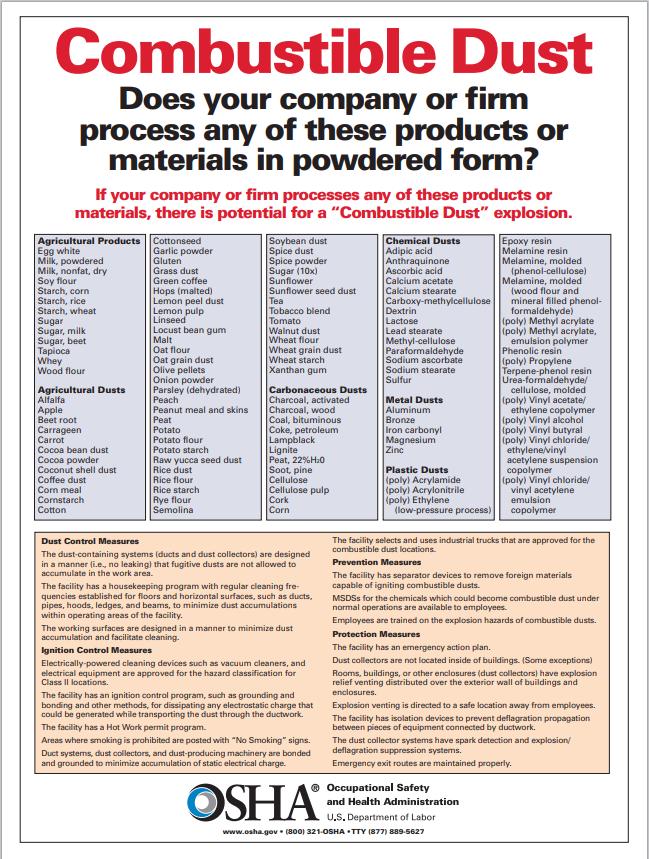
With the Occupational Safety and Health Act of 1970, Congress created the Occupational Safety and Health Administration (OSHA) to ensure safe and healthful working conditions for workers by setting and enforcing standards and by providing training, outreach, education and assistance, including combustible dust safety: Occupational Safety and Health Administration and Combustible Dust
OSHA initiated the Combustible Dust National Emphasis Program, (NEP) on October 18, 2007, following a number of combustible dust incidents that resulted in numerous deaths and many serious injuries. The details of some of these incidents can be found in a report published by the United States Chemical Safety and Hazard Investigation Board (CSB).
However, as a result of a catastrophic incident involving a combustible dust explosion at a sugar refinery, OSHA reissued the NEP on March 11, 2008, to increase its enforcement activities in specific industry groups that experienced either frequent combustible dust incidents or had the potential for combustible dust incidents with catastrophic consequences.
In fiscal years 2013 to 2017, OSHA conducted 2,553 combustible dust inspections – 910 programmed inspections and 1,253 un-programmed inspections. During this period, the agency found 3,389 combustible dust violations—1,022 from programmed inspections and 2,367 from un-programmed inspections.
During this period, the top five industries with combustible dust hazards were farm suppliers, institutional furniture manufacturers, metal window and door manufacturers, sheet metal work manufacturers, and reupholstery and furniture repairing operations.
Also during this period, animal food manufacturing, sawmills, wood manufacturing (e.g., cut-stock, re-sawing and planing), and agricultural processing facilities (e.g., grain and field beans) experienced the highest numbers of combustible dust-related fatalities and catastrophes.
The Revised Combustible Dust National Emphasis Program From OSHA
The Revised Combustible Dust National Emphasis Program from the Occupational Safety and Health Administration builds upon the lessons learned and experience gained since the original program’s launch. It incorporates the latest industry standards, best practices, and regulatory developments to better protect workers.
Key Components of the Revised Combustible Dust NEP:
Scope and Application:
The program applies to industries where combustible dust hazards are prevalent, including but not limited to manufacturing, woodworking, agriculture, food processing, metalworking, and chemical processing. This NEP helps identify facilities and employers most at risk.
Enhanced Inspection Procedures:
The Revised NEP provides guidance for OSHA compliance officers to conduct thorough and comprehensive inspections at workplaces that handle combustible dust materials. It outlines inspection procedures, including evaluating dust control measures, potential ignition sources, and housekeeping practices.
Risk Assessment:
The NEP emphasizes a risk-based approach. Employers are encouraged to assess the potential for combustible dust hazards and implement appropriate control measures. This includes conducting hazard assessments, implementing preventive measures, and providing adequate worker training.
Communication and Training:
Employers are required to provide workers with the necessary training and information about combustible dust hazards and control measures. Proper communication is vital for ensuring worker safety.
Enforcement:
The Revised NEP outlines the enforcement process, including the issuance of citations and penalties for non-compliance with combustible dust safety regulations. OSHA is committed to holding employers accountable for ensuring safe workplaces.
Resources and Outreach:
OSHA provides resources and educational materials to help employers and workers understand and address combustible dust hazards. Outreach efforts include webinars, seminars, and industry-specific guidance.
Collaboration with Industry:
OSHA collaborates with industry associations and stakeholders to stay updated on best practices, technological advancements, and evolving hazards. This ensures that the program remains relevant and effective.
The Revised Combustible Dust NEP represents OSHA’s continued commitment to protecting workers in industries prone to combustible dust hazards. By enhancing inspection procedures, encouraging risk assessment and preventive measures, and promoting open communication and collaboration, OSHA aims to reduce the risks associated with combustible dust and improve workplace safety.
Employers in affected industries are strongly encouraged to familiarize themselves with this program, follow the recommended practices, and collaborate with OSHA to create safer working environments for their employees. The Revised Combustible Dust NEP is a significant step towards preventing incidents related to combustible dust and reducing workplace hazards across various industries.
Combustible Dust and OSHA Regulations
To mitigate the risks associated with combustible dust, OSHA has implemented a series of stringent regulations. These regulations are designed to ensure the safety of workers and the protection of facilities. Some of the key regulations include:
29 CFR 1910.22: This general industry standard requires employers to maintain a clean and orderly workplace to prevent hazards, including those related to combustible dust. It emphasizes the importance of proper housekeeping and the regular removal of dust.
29 CFR 1910.307: OSHA’s electrical standard specifies requirements for equipment used in hazardous locations, such as areas with combustible dust. Proper electrical equipment is crucial in preventing ignition sources in dust-laden environments. OSHA 1910.307: OSHA sets the standard for general industry safety related to hazardous locations, including those where combustible dust is present. It outlines safety measures, equipment requirements, and training for workers in such environments.
29 CFR 1910.272: OSHA’s grain handling standard addresses dust hazards in grain handling facilities, mandating the use of dust control measures and safety procedures to protect workers.
The management of combustible dust is a critical aspect of workplace safety, and the proper design and operation of dust collection systems are key components in mitigating the associated risks. The NFPA and OSHA have developed comprehensive standards and regulations that serve as essential guidelines for industries to follow. Compliance with these standards and regulations is crucial in preventing explosions and fires, safeguarding the well-being of employees and the integrity of facilities where combustible dust is present. Companies must stay informed and uphold these safety measures to ensure a safe and productive working environment.
American Society for Testing and Materials International (ASTM) Standards for Combustible Dust
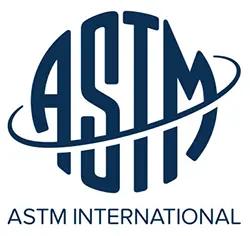
American Society for Testing and Materials International, ASTM International, is an international standards organization that develops and publishes voluntary consensus technical standards for a wide range of materials, products, systems, and services.
ASTM International, a globally recognized, and an international standards organization that develops and publishes voluntary consensus technical standards for a wide range of materials, products, systems, and services for developing and publishing industry standards. ASTM International has established comprehensive standards for mitigating the risks associated with combustible dust. Combustible dust poses a significant hazard in various industrial settings, where the accumulation of fine particles can lead to devastating dust explosions. To address this concern, ASTM has created a set of standards that cover Dust Hazard Analysis, Equipment, and Dust Explosion Protection, ensuring the safety of workers and the protection of industrial facilities.
ASTM International has several standards related to combustible dust, primarily under the designation “ASTM E”. These standards cover various aspects of combustible dust management, including:
ASTM E1226: Standard Test Method for Explosibility of Dust Clouds. This test method provides a procedure for performing laboratory tests to evaluate the deflagration parameters of dusts.
The data developed by this test method may be used for the purpose of sizing deflagration vents in conjunction with the nomographs and equations published in NFPA 68, ISO 6184/1, or VDI 3673.
The values obtained by this testing technique are specific to the sample tested and the method used and are not to be considered intrinsic material constants.
ASTM E1515: Standard Test Method for Minimum Explosible Concentration of Combustible Dusts This test method provides a procedure for performing laboratory tests to evaluate relative deflagration parameters of dusts.
The MEC, as measured by this test method, provides a relative measure of the concentration of a dust cloud necessary for an explosion.
Since the MEC, as measured by this test method, may vary with the uniformity of the dust dispersion, energy of the ignitor, and propagation criteria, the MEC should be considered a relative rather than absolute measurement.
These standards provide guidelines and best practices for industries dealing with combustible dust to assess risks, mitigate hazards, and ensure the safety of workers and facilities.
International Electrotechnical Commission (IEC) Standards

The International Electrotechnical Commission (IEC) standards reflect the global consensus and distilled wisdom of many thousand technical experts who are delegated by their countries to participate in the IEC.
They provide instructions, guidelines, rules or definitions that are then used to design, manufacture, install, test & certify, maintain and repair electrical and electronic devices and systems.
IEC International Standards are essential for quality and risk management; they help researchers understand the value of innovation and allow manufacturers to produce products of consistent quality and performance. IEC International Standards are always used by technical experts; they are always voluntary and based on the international consensus of experts from many countries.
International standards also form the basis for testing and certification.
International standards are also often adopted by countries or regions to become national or regional standards. For example, close to 80% of European electrical and electronic standards are, in fact, IEC International Standards.
International equipment regulations are often based on a combination of IEC and ISO standards, plus national or regional regulations such as the ATEX regulations and the set of CEN standards. Other countries have implemented special regulations for individual industries and facilities that are important to their economies.
IEC Standards for Combustible Dust Safety:
IEC 60079-10-2: Classification of Hazardous Areas – Combustible Dusts:
This standard provides a classification system for hazardous areas where combustible dusts may be present. It categorizes these areas into zones based on the likelihood of the presence of combustible dust and its persistence. This classification is essential for designing and selecting appropriate electrical equipment and systems for safe operation in such environments.
IEC 60079-0: General Requirements – Explosive Atmospheres:
This standard establishes general requirements for equipment intended for use in explosive atmospheres, including those with combustible dust. It covers design, construction, testing, and documentation to ensure the safety of electrical and electronic devices in these environments.
IEC 61241 Series: Electrical Apparatus for Use in the Presence of Combustible Dust:
The IEC 61241 series includes various parts, each focusing on specific aspects of electrical equipment for use in the presence of combustible dust. These standards address protection techniques, design principles, and test methods for equipment to prevent ignition and minimize the risk of explosions in dust-laden environments.
IEC 60079-31: Equipment Dust Ignition Protection by Encapsulation:
This standard outlines the requirements for electrical equipment protection through encapsulation to prevent ignition by combustible dust. It provides guidelines for the construction and testing of encapsulated equipment to ensure that it remains safe for use in hazardous dust environments.
IEC 60079-32: Equipment Dust Ignition Protection by Intrinsic Safety:
IEC 60079-32 focuses on intrinsic safety as a method to prevent ignition of combustible dust in electrical equipment. It defines safety parameters and requirements for electrical circuits to ensure that devices do not generate sufficient energy to ignite dust particles.
IEC 61241-11: Protection by Flow Restriction:
This standard specifies requirements for the design, construction, and testing of equipment using flow restriction as a protection method against dust ignition. It is particularly relevant for equipment that handles combustible dust in industrial processes.
The IEC standards for combustible dust safety play a crucial role in ensuring the protection of personnel, equipment, and the environment in industries where combustible dust is present. These standards provide a systematic and globally accepted approach to classifying hazardous areas, designing electrical equipment, and mitigating the risks associated with combustible dust. By adhering to these standards, industries can enhance safety measures and reduce the potential for explosions and fires in dust-laden environments, ultimately contributing to a safer work environment and protecting valuable assets.
International Organization for Standardization (ISO) regarding Combustible Dust
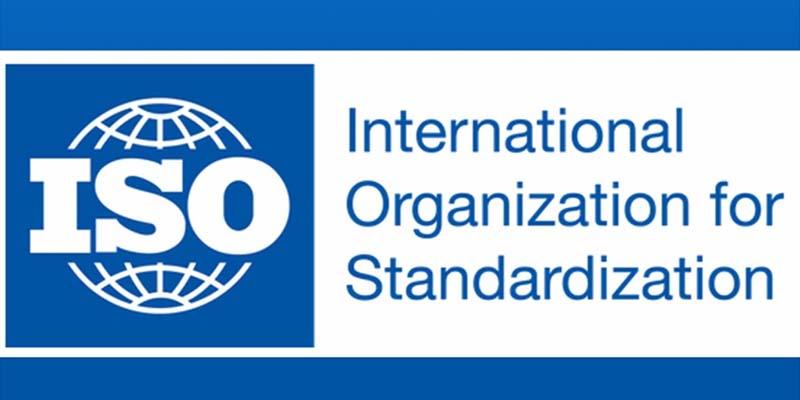
ISO standards for combustible dust safety are essential in ensuring the protection of employees, facilities, and the environment in industries where combustible dust is a concern. These standards provide a framework for the prevention of explosions and fires, as well as for the safe handling and disposal of dust in various industrial settings. By following ISO standards, organizations can enhance their safety measures, reduce the potential for accidents, and create a safer working environment for their employees while minimizing the environmental impact of their operations. Here are the standards pertaining to combustible dust:
ISO 6529:2013 – Explosive Atmospheres – Explosion Prevention Systems:
This standard sets the groundwork for preventing explosions in explosive atmospheres, including those with combustible dust. It provides a comprehensive framework for evaluating and implementing explosion prevention systems, making workplaces safer.
ISO 80079-37:2016 – Explosive Atmospheres – Non-electrical Equipment for Explosive Atmospheres – Basic Method and Requirements:
ISO 80079-37 focuses on non-electrical equipment used in explosive atmospheres, which include those with combustible dust. It provides a structured approach to designing, manufacturing, and certifying non-electrical equipment to prevent the ignition of combustible dust.
ISO 9000: Quality Management Systems:
While not specific to combustible dust, ISO 9000 is a foundational standard for quality management systems. Quality management is crucial for manufacturing processes that handle combustible dust, ensuring that safety measures are consistently adhered to and the risk of incidents is minimized.
ISO 14001: Environmental Management Systems:
ISO 14001 focuses on environmental management systems, which are vital for industries that deal with combustible dust. It helps organizations manage their environmental impact and ensures they have procedures in place for handling and disposing of dust and waste safely.
ISO 45001: Occupational Health and Safety Management Systems:
ISO 45001 is a key standard for promoting workplace safety. While not specific to combustible dust, it sets a framework for organizations to manage occupational health and safety risks. It is highly relevant to industries where combustible dust is present, as it emphasizes the need for risk assessment and preventive measures.
ISO 16017: Air Quality – Detection and Enumeration of Airborne Culturable Microorganisms at Ambient Temperature:
This standard, though not directly related to combustible dust, is significant for industries dealing with dust-laden environments. It provides guidelines for monitoring and managing air quality, which can help mitigate health risks associated with airborne particles, including dust.
ATEX “Atmosphere Explosibles” and Regulations for Combustible Dust
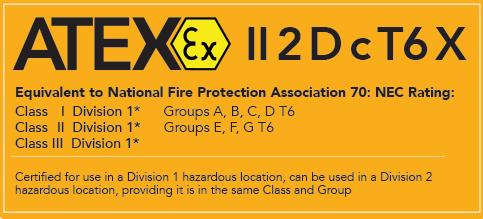
ATEX, short for “Atmosphères Explosibles,” is a European regulatory framework that pertains to equipment and protective systems intended for use in potentially explosive atmospheres. The ATEX standards play a crucial role in ensuring the safety of workers and equipment in environments where there is a risk of explosion due to combustible dust. These standards are primarily governed by two directives: ATEX Directive 2014/34/EU for equipment and ATEX Directive 1999/92/EC for workplace safety.
The ATEX standards concerning combustible dust are designed to mitigate the risks associated with the presence of combustible materials in industrial and commercial settings. Combustible dust refers to finely divided solid particles that can ignite and explode when suspended in the air in the right concentration. This risk can be found in various industries, such as food processing, woodworking, metalworking, pharmaceuticals, and chemical processing.
Key elements of the ATEX standards regarding combustible dust include:
Classification of Hazardous Areas: ATEX categorizes hazardous areas based on the likelihood of a combustible dust atmosphere. These areas are classified into three zones: Zone 20 (for continuous presence of dust), Zone 21 (for occasional presence of dust), and Zone 22 (for rare presence of dust).
Equipment and Protective Systems: ATEX Directive 2014/34/EU outlines the requirements for manufacturers and suppliers of equipment and protective systems intended for use in potentially explosive atmospheres. This includes machinery, electrical equipment, and other devices that need to be certified to ensure they are safe to use in these environments.
Risk Assessment: Employers are required to perform risk assessments to determine the potential for explosive atmospheres in their workplaces. They must identify hazardous zones and take appropriate measures to mitigate risks, such as implementing equipment suitable for the designated zone.
ATEX Marking: Products and equipment that comply with ATEX standards must bear the ATEX marking, which includes the Ex symbol and other relevant information, indicating their suitability for use in hazardous areas.
Documentation: Manufacturers and suppliers are obligated to provide detailed documentation and instructions for the safe installation, use, and maintenance of ATEX-certified equipment.
Worker Training: Employers are responsible for ensuring that workers are adequately trained and informed about the risks and safety measures associated with combustible dust atmospheres.
ATEX Directive 1999/92/EC: This directive focuses on the responsibilities of employers to protect workers in potentially explosive atmospheres. It requires risk assessments, safety management systems, and the implementation of protective measures.
National Regulations: ATEX standards are harmonized across the European Union, but individual member states may have additional regulations and requirements to complement ATEX standards, so it’s important for businesses to comply with both EU and national regulations.
Compliance with ATEX standards is crucial to prevent accidents and explosions in workplaces with combustible dust hazards. It not only ensures the safety of workers but also protects valuable equipment and infrastructure. Businesses operating in the European Union need to be aware of these regulations and work towards full compliance to ensure a safe working environment in potentially explosive atmospheres.
CEN, European Committee for Standardization, Regarding Combustible Dust

CEN, the European Committee for Standardization, is an association that brings together the National Standardization Bodies of 34 European countries. CEN provides a platform for the development of European Standards and other technical documents in relation to various kinds of products, materials, services and processes. CEN supports standardization activities in relation to a wide range of fields and sectors, including:
- Air and Space
- Chemicals
- Construction
- Consumer products
- Defense and Security
- Energy
- The environment
- Food and feed
- Health and Safety
- Healthcare
- ICT
- Machinery
- Materials
- Pressure equipment
- Services
- Smart living
- Transport and Packaging
CEN, the European Committee for Standardization, has developed specific standards and technical specifications related to combustible dust hazards to ensure safety in various industries. Here is a list of some key standards and documents related to combustible dust issued by CEN:
EN 1127-1:2007 – Explosive atmospheres – Explosion prevention and protection – Part 1: Basic concepts and methodology: This standard provides the fundamental concepts and methodology for assessing and managing the risks of explosive atmospheres, including those caused by combustible dust.
EN 14034-3:2011 – Explosion prevention and protection in the design of ventilation systems – Part 3: Gas and dust explosion venting: This standard focuses on the safe design of ventilation systems in areas with a risk of gas and dust explosions. It covers explosion venting for dust.
EN 15089:2013 – Explosion venting devices: This standard specifies requirements and testing methods for explosion venting devices designed to protect equipment and personnel from the effects of dust explosions.
EN 50177:1998 – Explosive atmospheres – Electrical installations design, selection and erection: This standard addresses the electrical aspects of equipment used in explosive atmospheres, including those with combustible dust. It provides guidelines for the safe installation of electrical systems.
EN 13463-1:2001 – Non-electrical equipment for use in potentially explosive atmospheres – Part 1: Basic method and requirements: This standard outlines the basic requirements for non-electrical equipment used in potentially explosive atmospheres, including equipment suitable for dust environments.
EN 12779:2004 – Non-electrical equipment for use in potentially explosive atmospheres – Protection by flow restricting enclosure “fr”: This standard specifies the requirements for flow restricting enclosures used as a protective measure in explosive atmospheres, including those with combustible dust.
EN 14034-1:2004 – Explosion prevention and protection in the design of ventilation systems – Part 1: General requirements: This standard sets general requirements for the prevention and protection against explosions in ventilation systems, including those caused by dust.
EN 14034-4:2005 – Explosion prevention and protection in the design of ventilation systems – Part 4: Venting: Part 4 of this standard specifically addresses explosion venting in ventilation systems to protect against dust explosions.
EN 14491:2006 – Explosive atmospheres – Explosion protection by equipment “d”: This standard defines the requirements for equipment that is designed to be used in environments with a risk of explosion, including those with combustible dust.
EN 15089:2013 – Explosion venting devices: This standard specifies requirements and testing methods for explosion venting devices designed to protect equipment and personnel from the effects of dust explosions.
These standards help ensure the safety of workers, protect equipment, and mitigate the risks associated with combustible dust hazards in various industrial and commercial settings. Businesses operating in the European Union should be familiar with these standards and incorporate them into their safety management systems to minimize the potential for dust-related accidents and explosions.
Your safety, your responsibility—enroll in our online course and be equipped to handle combustible dust hazards like a pro.
Underwriters Laboratory Combustible Dust Certification

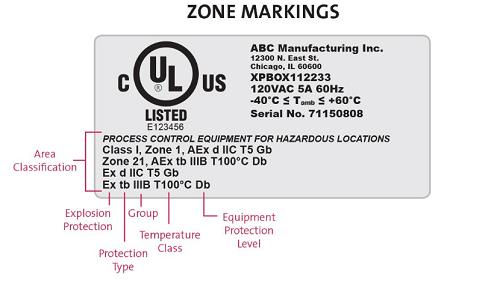
Underwriter Laboratories is a global leader in applied safety science. UL Solutions transforms safety, security, and sustainability challenges into opportunities for customers in more than 100 countries. UL Solutions delivers testing, inspection and certification services, together with software products and advisory offerings, that support our customers’ product innovation and business growth. UL certification process, participates in over 50 Standards writing committees, such as: TC31 (IECEx), UL STP (North America), NFPA, API, BSEE and CFR committees.
(UL) 1203 Standard for Explosion-Proof and Dust-Ignition-Proof Electrical Equipment for Use in Hazardous (Classified) Locations:
(UL) 1203 is defined as the “Standard for Explosion-Proof and Dust-Ignition-Proof Electrical Equipment for Use in Hazardous (Classified) Locations.” The rationale for this regulation is to prevent explosions and dust ignitions in industrial settings as flammable gases, vapors, mists, and dusts are inevitably created in many processes. The 1203 UL is designated for a sealing/potting compound for use in hazardous locations conforming with Class I, Groups A, B, C and D; Class II, Groups E, F, and G Hazardous Locations.
The Importance of UL 1203 for Combustible Dust Equipment:
UL 1203, the standard for Explosion-Proof and Dust-Ignition-Proof Electrical Equipment for Use in Hazardous (Classified) Locations, plays a crucial role in ensuring the safety of equipment in environments prone to combustible dust. Here’s why compliance with UL 1203 is paramount:
1. Mitigating Explosion Risks
UL 1203 sets rigorous criteria for electrical equipment to withstand potential ignition sources in environments where combustible dust is present. By adhering to this standard, manufacturers design and produce explosion-proof equipment that significantly reduces the risk of electrical sparks or arcs causing dust explosions. This is particularly vital in industries where dust clouds can form and pose an explosive hazard.
2. Stringent Testing Procedures
The standard outlines comprehensive testing procedures to evaluate the equipment’s ability to contain potential explosions and prevent them from igniting surrounding combustible dust atmospheres. These tests assess the equipment’s construction, sealing, and durability under simulated hazardous conditions, ensuring a high level of reliability in real-world scenarios.
3. Certification Assurance
Equipment certified under UL 1203 provides assurance to industries and regulatory bodies that the product has undergone rigorous testing and meets specific safety standards. This certification enhances confidence in the reliability and safety of electrical equipment used in locations where combustible dust is a concern.
4. Compliance with Regulatory Requirements
Many industrial safety regulations and codes mandate compliance with standards such as UL 1203 for electrical equipment in hazardous locations. Meeting these requirements is not only a legal obligation but also a practical necessity for safeguarding workers, facilities, and the surrounding environment from the potentially devastating consequences of combustible dust-related incidents.
5. Global Recognition
UL 1203 is globally recognized, providing a standardized approach to electrical equipment safety in hazardous locations with combustible dust. This ensures consistency and compatibility of equipment across different regions, facilitating international trade and promoting a unified commitment to safety standards.
Adherence to UL 1203 is instrumental in the design, manufacturing, and deployment of electrical equipment in environments where combustible dust poses a risk. This standard plays a pivotal role in preventing catastrophic incidents, protecting both personnel and property from the inherent dangers associated with combustible dust atmospheres.
VDI, Verein Deutscher Ingenieure, Safety Standard Regarding Combustible Dust
The VDI safety standard is used in Germany, regarding combustible dust. VDI is short for Verein Deutscher Ingenieure, which is the Association of German Engineers.
Being part of the European Union, Germany works under the ATEX Directive, but the European approach is to allow every country to adopt its own guidelines. For combustible dust hazards, the appropriate standard in Germany is VDI 2263, which applies to certain types of equipment. For example:
- 2263.6 covers dust collectors, baghouses, and filters
- 2263.7 is directed at spray dryers
- 2263.8 is aimed at bucket elevators
Although not a law, VDI consists of state-of-the-art guidelines from German engineers, making it a recommended standard to follow.
VDI’s standards generally focus on various aspects related to safety in handling combustible materials, including risk assessment, hazard identification, prevention and protection measures, equipment design, installation, and maintenance. These standards often align with European Union directives and regulations aimed at ensuring workplace safety, risk reduction, and the prevention of accidents caused by combustible dust.
VDI’s contributions to safety standards encompass interdisciplinary approaches, drawing insights from engineering, technology, and industrial practices to create comprehensive guidelines. These standards emphasize a proactive approach to identify and mitigate combustible dust hazards, promote safety-conscious work environments, and reduce the likelihood of dust-related incidents such as fires or explosions.
Industries adhering to VDI safety standards regarding combustible dust benefit from a framework designed to enhance safety protocols, implement efficient prevention measures, and protect personnel, equipment, and facilities from potential hazards. VDI’s standards contribute significantly to fostering safer workplaces and promoting continuous improvement in safety practices across various industries dealing with combustible dust.
Protect your workplace and employees—gain life-saving skills with our expert-led combustible dust safety training.
The International Fire Code (IFC) Chapter 22, Regarding Combustible Dust
The International Fire Code (IFC) Chapter 22 specifically addresses combustible dust hazards within facilities, providing essential guidelines and regulations to mitigate the risks associated with combustible dust.
IFC Chapter 22 focuses on preventing fires and explosions caused by combustible dust in various industries, including manufacturing, woodworking, food processing, pharmaceuticals, and more. This chapter outlines requirements for controlling dust accumulation, implementing preventive measures, and establishing safety protocols to minimize the potential for dust-related incidents.
Key elements of IFC Chapter 22 include provisions for managing combustible dust, including dust collection systems, housekeeping practices, ventilation, equipment design, and hazardous location classifications. It emphasizes the importance of conducting risk assessments, identifying potential dust hazards, and implementing appropriate control measures to prevent dust explosions.
The IFC’s Chapter 22 aligns with international best practices and standards for managing combustible dust, intending to create safer environments for workers, protect property, and prevent catastrophic events. It often draws from recognized codes and standards, such as NFPA, OSHA, and other reputable sources, to establish comprehensive guidelines for controlling combustible dust hazards.
Key Prevention Measures for Combustible Dust Explosions

Preventing Combustible dust explosions begins with several crucial proactive measures. The several prevention measures and strategies include:
1) Awareness and Identifying Potential Hazards with Combustible Dust
Awareness starts with recognizing the existence of combustible dust in the workplace. Many employees and management might not be fully aware of the risks associated with combustible dust particles.
Through education and training, as well as a dust hazard analysis, individuals can learn to identify potential sources of combustible dust and be vigilant in their presence. Industrial facilities can promote awareness regarding combustible dust explosions in several ways:
-
- Training Programs: Implement comprehensive training programs that educate employees at all levels about the risks associated with combustible dust. These programs should cover identification, prevention, and response strategies.
- Regular Communication: Maintain open lines of communication between employees, management, and safety officers. Regularly discuss safety measures and encourage employees to report any concerning conditions.
- Safety Campaigns: Launch safety campaigns that emphasize the importance of awareness in preventing dust explosions. Use posters, pamphlets, and workshops to engage and inform employees.
- Continuous Learning: Awareness should be an ongoing process. Stay updated on the latest Standards, Regulations, equipment, safety practices, and technological advancements in dust explosion prevention and protection.
- Management Support: Ensure that the organization’s leadership is fully supportive of awareness initiatives. Management’s commitment to safety sends a powerful message to the entire workforce.
- Reward System: Implementing a reward system, for prevention of Combustible Dust explosions, can be an effective and innovative approach.
2) Implementing a Reward System for the Prevention of Combustible Dust Explosions
The reward system focuses on incentivizing and promoting best practices in combustible dust explosion prevention. It encourages employees at all levels, from floor workers to management, to actively participate in maintaining a safe environment. By rewarding individuals and teams who contribute to dust explosion prevention efforts, the system not only recognizes their dedication but also fosters a culture of safety within the organization.
The key components of this reward system include the identification of combustible dust hazards, regular maintenance and cleaning, adherence to safety protocols, and active reporting of potential hazards. By tying these activities to tangible rewards, organizations can motivate their workforce to remain vigilant and proactive in preventing dust explosions.
The implementation of a reward system for preventing combustible dust explosions is a proactive and engaging strategy for industrial manufacturing facilities. It not only enhances safety measures but also instills a culture of prevention, ultimately reducing the risk of catastrophic dust explosions and safeguarding employees and assets.
Conclusion
Understanding and preventing combustible dust explosions is paramount to ensuring workplace safety, protecting lives, and mitigating the devastating consequences that such incidents can bring.
Importance of Preventing and Protection from Combustible Dust Explosions:
Preventing combustible dust explosions is not merely a regulatory requirement; it is an ethical and practical imperative. The consequences of these incidents extend beyond financial losses and legal liabilities, encompassing the loss of human lives and environmental damage. A comprehensive understanding of combustible dust hazards and a commitment to prevention can lead to:
- Safety Enhancement: Protecting the lives of workers and the public by minimizing the risk of explosions
- Legal Compliance: Avoiding penalties, fines, and legal consequences associated with non-compliance
- Positive Reputation: Attracting customers and business partners by demonstrating a commitment to safety
- Insurance Benefits: Reducing insurance costs and improving coverage options
- Continuous Improvement: Fostering a culture of ongoing safety improvement and risk reduction within organizations
Combustible dusts are a significant concern in industries that involve the manufacturing, processing, and handling of combustible particulate solids like metals, wood, and grain. The NFPA Standards Council has developed a set of NFPA standards specifically aimed at mitigating explosion hazards and fires and dust explosions in these environments. For instance, NFPA 660 is a comprehensive standard for the prevention of such incidents and covers essential practices for handling combustible dusts across sectors, including wood processing and grain handling facilities. By following these combustible dust standards, industries can address recognized hazards and reduce risks associated with explosion hazards and flash fire events.
The fundamentals of combustible dust management extend to various safety protocols, including the general duty clause and OSH Act requirements, which mandate that employers must ensure their workplaces are free of serious injury risks from fire and dust explosions. The use of dust collectors in woodworking facilities or sulfur fires in chemical plants, for instance, illustrates the importance of materials handling practices in preventing explosion hazards. A comprehensive hazard analysis can identify areas where combustible metals NFPA guidelines should be applied to prevent flash fires and static electricity-related incidents in environments where explosions from the manufacturing processes could occur.
Compliance with combustible dust standards is critical to industrial safety, as it requires continuous attention to handling combustible particulate and maintaining safe walking working surfaces. Additionally, the NFPA Standards Council emphasizes the importance of addressing explosion hazard factors and the effective application of dust standards in manufacturing, processing, and handling sectors. Implementing these codes and standards, such as NFPA 660, helps facilities mitigate explosion hazards and reduce risks of fires and explosions that can lead to serious injury. Ensuring compliance with these NFPA standards enhances workplace safety, particularly in sectors like wood processing and woodworking where dust collectors and rigorous materials handling practices are essential.
Ready to enhance your safety knowledge? Contact us for expert guidance on managing combustible dust risks effectively!
Recommendations for Further Reading and Resources:
-
- NFPA Standards: Explore the National Fire Protection Association’s guidelines and standards related to combustible dust (NFPA 652, NFPA 654, etc.).
- OSHA Resources: The U.S. Occupational Safety and Health Administration (OSHA) offers valuable resources on combustible dust safety.
- European ATEX Directive: Study the ATEX directive for European Union member states, which focuses on equipment used in potentially explosive atmospheres.
- Industry Publications: Many industry-specific publications and journals provide in-depth information on combustible dust hazards and prevention measures.
- Safety Training Programs: Consider enrolling in safety training programs that cover combustible dust safety and risk assessment.
- Government Guidelines: Review the guidelines and resources provided by relevant government agencies in your region, such as the Health and Safety Executive (HSE) in the UK.
- International Safety Organizations: Explore international safety organizations and their publications, like the Institution of Chemical Engineers (IChemE).
Understanding and preventing combustible dust explosions is an ongoing and crucial endeavor for industries worldwide. The importance of safety, compliance, and a proactive approach cannot be overstated, as these measures protect lives, assets, and the environment. By staying informed, adopting best practices, and fostering a culture of safety, organizations can effectively reduce the risk of combustible dust explosions and contribute to safer workplaces globally.
About Dust Safety Science
Dr. Chris Cloney, of Dust Safety Science, provides additional Combustible Dust information, with a Podcast. Click on the latest Podcast Link: 10 Videos to Demonstrate and Educate About Dust Explosion Hazards

Resources:
Visit Dust Safety Science (Global Incident Tracking)
Visit Dust Safety Academy (Resources, Training and Events)
Visit Dust Safety Professionals (Need Help? Get Support Today!)
Visit Dust Safety Journal for the Dust Safety Science Monthly Journal
Subscribe to our Dust Safety Science Newsletter at Dust Safety Science Newsletter
Visit the Dust Safety Science blog for written articles on combustible dust safety including the latest research, expert opinions, and state-of-the art fire and explosion protection.
